NFL 2024 overtime rules: Time allowed, coin toss and how the format works for regular season and playoff games
The NFL overtime rules can seem a bit complicated. Every couple of years there are changes to the rules that can make it hard to keep up at times. NFL officials have some of the toughest jobs in all of professional sports (Photo by Amy Lemus/NurPhoto via Getty Images)Getty Images - Getty To make it even more confusing, the overtime rules are slightly different in the regular season than they are in the play-offs. Not by much, but there is a huge difference, which will be explained. So what exactly are the rules as they currently stand? How does overtime work in the regular season? When the clock hits zero at the end of the game and the score is tied, the game will go into overtime. The overtime period is an extra 10-minute quarter where each team receives two timeouts. To determine who receives the ball first, both teams will send a player to centerfield and participate in a coin toss, exactly like the one that takes place at the beginning of every game. The visiting team will still be the one to call the coin toss, which will determine who gets the ball first and who defends which side of the field. Both teams will have an opportunity to possess the ball, unless the team that receives the ball first goes down the field and scores a touchdown. In that case, the game is over and the losing team does not get a chance at a rebuttal. However, if the team that receives the ball first only scores a field goal on their first possession, then the second team will get a chance to either kick a field to extend the game, or win the game with a touchdown. NFL officials briefly remind the coaching staff, fans and TV audience before each OT period begins, what the rules are (Photo by Aaron M. Sprecher/Getty Images)Getty Images - Getty If the team who receives the ball first comes away without any points, then the second team will only need to kick a field goal to win the game. If neither team scores on their initial possession, then it becomes a true sudden death period, where the next score wins. If the game is still tied at the end of the overtime period, then the game will result in a tie. There are no coach’s challenges in overtime, as all instant replay reviews are initiated by the officials. How does overtime work in the play-offs? The most notable difference in the overtime period in the postseason than the regular season, is that even if the team who receives the ball first scores a touchdown, the second team will still get the opportunity to receive the ball and score a touchdown to extend the game. This rule change was the result of Patrick Mahomes and the Kansas City Chiefs beating Josh Allen and the Buffalo Bills in one of the most memorable play-off games in all time. In the divisional round in 2021, the Chiefs received the ball first in overtime and drove down the field for a touchdown, and the game was over. Allen never touched the ball in OT. This left a lot of people upset and with a sour taste in their mouths. That prompted the rule change where no matter what, both teams will get a possession. If the score is still tied at the end of an overtime period — or if the second team’s initial possession has not ended — the teams will play another overtime period. Play will continue regardless of how many overtime periods are needed for a winner to be determined. The Chiefs won the Super Bowl in overtime against the San Francisco 49’ers last season (Photo by Michael Owens/Getty Images) If there is more than one overtime period, there will be a two-minute intermission between each period, however there will not be a halftime intermission after the second period. As opposed to the two timeouts each team gets in the regular season OT period, each team receives three timeouts for the postseason OT period. If somehow there is still no winner at the end of a fourth overtime period, then there will be another coin toss, and play will continue until a winner is declared. That wasn’t so complicated, was it?

The NFL overtime rules can seem a bit complicated.
Every couple of years there are changes to the rules that can make it hard to keep up at times.

To make it even more confusing, the overtime rules are slightly different in the regular season than they are in the play-offs.
Not by much, but there is a huge difference, which will be explained.
So what exactly are the rules as they currently stand?
How does overtime work in the regular season?
When the clock hits zero at the end of the game and the score is tied, the game will go into overtime.
The overtime period is an extra 10-minute quarter where each team receives two timeouts.
To determine who receives the ball first, both teams will send a player to centerfield and participate in a coin toss, exactly like the one that takes place at the beginning of every game.
The visiting team will still be the one to call the coin toss, which will determine who gets the ball first and who defends which side of the field.
Both teams will have an opportunity to possess the ball, unless the team that receives the ball first goes down the field and scores a touchdown.
In that case, the game is over and the losing team does not get a chance at a rebuttal.
However, if the team that receives the ball first only scores a field goal on their first possession, then the second team will get a chance to either kick a field to extend the game, or win the game with a touchdown.

If the team who receives the ball first comes away without any points, then the second team will only need to kick a field goal to win the game.
If neither team scores on their initial possession, then it becomes a true sudden death period, where the next score wins.
If the game is still tied at the end of the overtime period, then the game will result in a tie.
There are no coach’s challenges in overtime, as all instant replay reviews are initiated by the officials.
How does overtime work in the play-offs?
The most notable difference in the overtime period in the postseason than the regular season, is that even if the team who receives the ball first scores a touchdown, the second team will still get the opportunity to receive the ball and score a touchdown to extend the game.
This rule change was the result of Patrick Mahomes and the Kansas City Chiefs beating Josh Allen and the Buffalo Bills in one of the most memorable play-off games in all time.
In the divisional round in 2021, the Chiefs received the ball first in overtime and drove down the field for a touchdown, and the game was over. Allen never touched the ball in OT.
This left a lot of people upset and with a sour taste in their mouths.
That prompted the rule change where no matter what, both teams will get a possession.
If the score is still tied at the end of an overtime period — or if the second team’s initial possession has not ended — the teams will play another overtime period.
Play will continue regardless of how many overtime periods are needed for a winner to be determined.

If there is more than one overtime period, there will be a two-minute intermission between each period, however there will not be a halftime intermission after the second period.
As opposed to the two timeouts each team gets in the regular season OT period, each team receives three timeouts for the postseason OT period.
If somehow there is still no winner at the end of a fourth overtime period, then there will be another coin toss, and play will continue until a winner is declared.
That wasn’t so complicated, was it?


























































